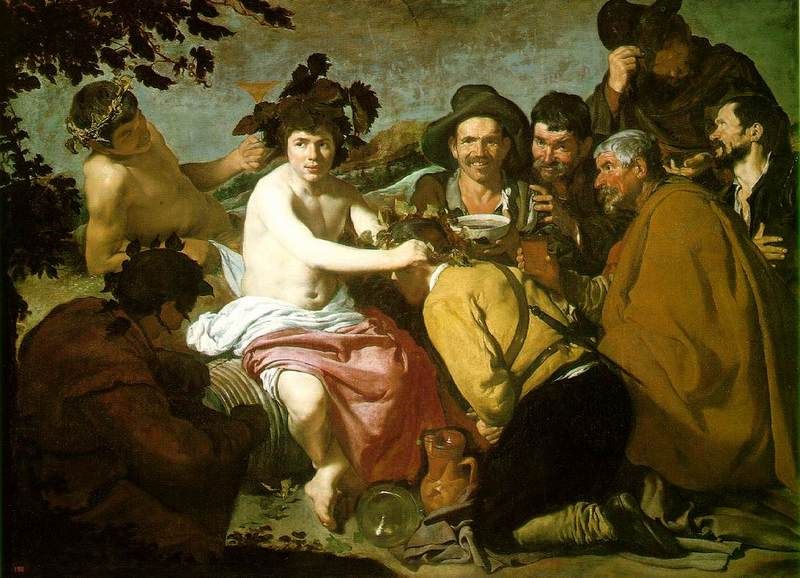
Diego Velázquez, "Los Borrachos" c. 1620. I think the character at far upper right may be the Fourth Doctor.
In this blog from time to time I make use of the philosophical and literary concept of the dichotomy between Apollonian and Dionysian elements. It was famously invoked by Friedrich Nietzsche in "The Birth of Tragedy". I picked it up from Stephen King's 1981 nonfiction work "Danse Macabre". King utilized the term to discuss the archetypical horror character who undergoes a transformation from normal, cultured or in some cases highly reasoned, to a feral, animalistic state. The clearest examples of this are probably the 1886 Robert Louis Stevenson novella "Strange Case of Doctor Jekyll and Mister Hyde" and the ancient legends of werewolves and other shape changers.
I've used the term to describe the Incredible Hulk from Marvel Comics. The pattern is quite clear in the Hulk. It is truly the prehistoric occult legend with modern era nuclear science and radiation fulfilling the role of magical curse. Apollonian physicist Bruce Banner was caught in the blast of his own gamma bomb. The bombardment of gamma rays caused periodic transformation into the Dionysian Hulk.
But this article is not primarily about the Hulk or the Apollo/Dionysus dichotomy. Recently several factors have caused me to take consideration of the purely Dionysian character.
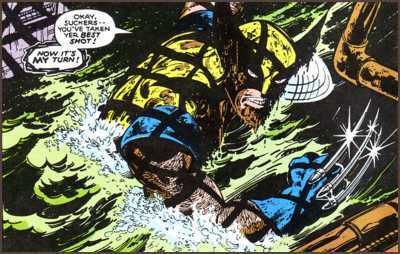
Art by John Byrne
The myth of Dionysus is ancient, complex, and vitally important at the heart of matters as we discuss the esoteric Underground Stream and the Invisible College. There is evidence suggesting the existence of Dionysian Mystery Schools in Greece as early as 6,000 BC with the original import of wine. It likely was transmitted from the area between Mesopotamia and Persia, or Northern Africa. The Dionysian Mysteries were a precursor to the Eleusian Mysteries, Orphism and Gnosticism.
Dionysus/Bacchus is of course the god of wine, agriculture and theater. His patronage of theater is a vital point. It is Bacchus who oversees the allegorical tale, the Spoonful of Sugar that helps the Medicine go down. This displays the inherent relationship between popular entertainment and the initiatory rites of the Mystery Schools. Comic books are a form of theater, the writer is the play write, the illustrator the director and all of the actors. As a figure who passes into the Underworld and back again Dionysus further carries connotations of the links between the living and the dead.
He is Dionysus Dimetor because he has two Mothers. He is a son of Zeus and the mortal woman Semele. Semele was the daughter of the hero Cadmus, credited as the creator of the Phoenician alphabet. Cadmus, following the guidance of Athena, sowed the teeth of a dragon which grew into soldiers. Teeth, crops, soldiers and letters all stand in rows. Semele was a priestess of Zeus and the god seduced her in the form of an Eagle, a solar symbol and Scorpio emblem. When Hera learned Semele was pregnant she disguised herself as a crone and befriended Semele, casting doubts in the priestess' mind that the Eagle formed Zeus was truly who he claimed to be. Semele demanded Zeus to reveal to her his true form, but her mortal eyes could not look upon his glory. She was wreathed in holy lightning and incinerated. Zeus saved his unborn child by sewing him into his thigh. Dionysus Eriaphiotes is Dionysus Insewn.
Dionysus is also Zagreus. Orphic tradition describes Zeus, in the form of a Snake (again a Scorpio emblem), impregnating either the mother Demeter or the daughter Persephone, producing the infant Zagreus. Hera coerced the Titans into dismembering Zagreus, but Athena rescued his still beating heart and returned it to Zeus. Zeus produced mead from the heart and gave it to Semele to drink, impregnating her with Dionysus Dimetor. The name Zagreus was utilized in the Doctor Who radio dramas as a legendary entity of Gallifrey who lived at the end of time.
The adult Dionysus, like Doctor Doom (and note the similarity to Orpheus and Dante), entered Hades and rescued Semele from the Underworld, making her a goddess of Olympia, where she resided over the ecstatic frenzies generated by her son. These divine states of madness, the bakcheia, are central to the Dionysus Mysteries. The Dionysian Mysteries included ceremonial rites to achieve these trance states through intoxication through wine (and possibly other substances), rhythmic chanting, drumming and dancing. Indeed it is quite clear that Dionysus is the patron deity of sex, drugs and rock and roll. This is something Jim Morrison, for example, understood quite well.
Dionysus' resurrection traits are a factor he shares with many solar, agricultural deities, as is his description as androgynous. Called "the Lord of Beasts", he is depicted often in the company of satyrs, centaurs and other synthetic creatures representing "higher" human form combined with "lower" bestial attributes. Symbols of Dionysus include the bull, the serpent, cats (especially so big cats like leopards and panthers), swarms of bees (perhaps a holdover from earlier Mead Cults), the grape vine (naturally), ivy, figs, pine cones (attaching him to Cybele), and pomegranates (attaching him to Demeter and Persephone). In the Eleusian Mysteries he was Dionysus Iacchus, "the light bearing star of the nocturnal mysteries", associated with Sirius, the torch bearer who led the Eleusian procession.
Amongst his other many epithets are Aegobolus (the Goat-killer), Bromios (Thunderer/He Who Shouts), Dendrites (Of the Trees), Eleutherios (the Liberator), Enorches (With Testicles), and Sabazios (The Shatterer). There is a vital relationship between Dionysus and Hermes, beyond both being sons of Zeus. To keep Dionysus safe from the wrath of Hera he was put in the care of Hermes. In some versions Hermes gave Dionysus to King Athamas and Dionysus' aunt Queen Ino, instructing them to keep Dionysus hidden by raising him as a girl. Another version had Hermes placing Dionysus in the care of the rain nymphs the Nysa (Dio=Zeus, Nysus=the Nysa). As a reward for their nurturing (rain nurses grapes) the Nysa were catasterized as the Hyades.
The nature of Dionysus as an enlightener is encoded within his mythology. At one point he was driven mad by Hera and later cured by Cybele. He was then sent to Asia to teach grape culture and the wine cult and was said to have resided in India for many years. Another interesting episode involved Dionysus, disguised as a young beautiful mortal, being kidnapped and taken to sea by sailors intending to ransom the youth or sell him into slavery. However, Dionysus, the Liberator, can not be bound. He became a lion and unleashed savage fury on the ship's crew. Those sailors that chose to jump into the sea rather then be dismembered were transformed into dolphins. Another version of this story also featured the ship being overrun with snakes and ivy, and the sailors being driven mad by the sounds of flutes (a device utilized by Lovecraft).
Dionysus is indeed not known for his gentle or forgiving nature. In the Eurpides tragedy "The Bacchae" Dionysus traveled to Thebes to enact vengeance upon his aunts and his cousin, the king Pentheus, for denying his mortal mother's claims of Dionysus' divine parentage. To this end he inducted the Theban women as Maenads and drove them into an ecstatic frenzy, in which state they tore Pentheus to pieces.
Dionysus' primary consort was the mortal Ariadne, the Minoan princess who aided Theseus in the labyrinth with her magic ball of thread. He was also said to have fathered Nyx's son Phthonus, the embodiment of jealousy, and Aphrodite's children the Charities (the Roman Three Graces), Hymenaios, god of marriage, and the male fertility god Priapus. Dionysus as the father of Priapus is very interesting. Often when these mythological models transfer the relationships of the characters is altered. This seems to be the case with the Dionysian Wolverine, a character who was "born" in the pages of the Incredible Hulk.
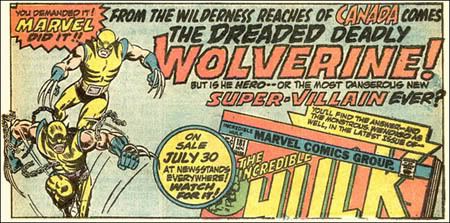
Art by Herb Trimpe. Note how in this ad introducing Wolverine, binding chains leap from his form.
Yes, I did just say that about the Hulk. The sexual connotations of Wolverine are likewise readily apparent. If comic book super heroes represent the power fantasies of the disenfranchised, then surely the erectile, penetrating, untiring Wolverine is a male, adolescent personal virility fantasy come to life. Wolverine's claws are made out of an imaginary metal called adamantium, the hardest substance of the Marvel Universe. Wolverine's bones are likewise bonded with the metal, making them unbreakable. In the nineties Wolverine's origin was retconned. Previously the claws were described as bionic implants, separate from his mutant abilities. Now the retractable claws (which Wolverine "pops") are natural bone extrusions coated with adamantium. This reinforces the sexual symbolism to such a degree that one might think this alteration was performed tongue in cheek.
As seen in the Marvel house ad above, Wolverine was first introduced at the end of "The Incredible Hulk" #180, October 1974, with his first full appearance in the following issue. He was created by writer Len Wein and illustrators John Romita and Herb Trimpe. The character next appeared in May, 1975's "Giant-Size X-Men" #1, which was also written by Wein and illustrated by Dave Cockrum. He appeared thereafter as one of the "New" X-Men starting with "X-Men" #94. Beginning with that issue the X-Men title was written by Chris Claremont for 16 consecutive years, making him largely responsible for shaping the character into the highly popular franchise he is for Marvel Comics today.
Wolverine, also known as Logan (a Scottish name meaning "little hollow", which could be extrapolated to mean "vessel"), resonates Dionysus on several levels. Besides his claws his powers include animal-like heightened senses, enhanced physicality and a "healing factor" that allows him to heal any wound, injury or poisoning almost instantaneously. It is worth noting that while Wolverine is clearly an animalistic character, the regeneration ability is more naturally a vegetative attribute.
Another key Wolverine characteristic is his propensity to go into what is termed a "beserker rage" in which he turns into a furious, indiscriminate killing machine. This is easily comparable to the violent, ecstatic states of the Maenads. Often described as an anti-hero, Wolverine was the rare comic book super hero who smoked cigarettes and drank alcohol on a regular basis. But he was not just an indiscriminate death-dealer. When handled properly there is reason and justice underlying his actions, making him something of a prototype of Dexter. Like Dexter, Wolverine is cognizant of his dark nature. His most embelmatic line is "I'm the best there is at what I do, but what I do best isn't very nice". As the character developed over the years he was shown to contain a sense of honor and code of ethics like a feudal samurai.

Art by Frank Miller
There is an Apollonian/Dionysian dichotomy associated with the character, but in the case of the X-Men it is a struggle between two separate figures, Wolverine and the solar powered, beam emitting, highly rational Cyclops. Immediate sexual tension was generated between Wolverine and Cyclops' long-time girlfriend Jean Grey, the all-important Marvel Girl and future Phoenix, who can be said to be the High Priestess of the Marvel Mysteries.
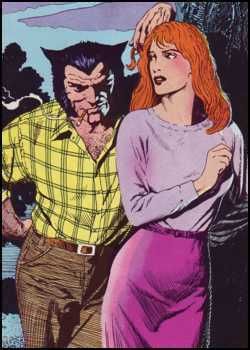
Art by John Bolton
Another long-running feature of Wolverine was his state of amnesia. His past was a mystery, and his earliest memories involved the laboratory procedures in which the adamantium was "insown" to his skeleton. Thus he could be said to be "twice born". This portion of Wolverine's story was beautifully presented in 1991 in Marvel's anthology series "Marvel Comics Presents" #s 72-84 by the great Barry Windsor-Smith.
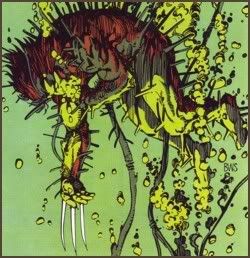
Note the vine-like forms in this image of Wolverine's second womb.
While in the early years of his term as an X-Men Wolverine was a wild card who didn't follow orders, he developed into a mainstay of the team. He developed a particularly strong relationships with Nightcrawler, the blue, devil-like teleporter, and Kitty Pryde, to whom he became a surrogate father. The 1984-85 limited series "Kitty Pryde and Wolverine" essentially depicted Wolverine initiating the novice hero Kitty Pryde into a dangerous combatant with ninja-level skills. Indeed Wolverine has strong ties to several female characters. His relationship with Kitty was reproduced with Jubilee, and with Rogue in the first X-Men film. When Wolverine was finally given a full origin (I personally preferred him without it, but then I like the mystery), his true name was revealed as James Howlett. Compare this to the Dionysian epithet Bromios, "He Who Shouts".
Like many of the X-Men characters, Wolverine seems difficult for many writers to get a proper handle on. This, combined with his vast marketability, has made for literally hundreds of wholly unreadable comic books featuring the character. As a fan of the classic X-men (for me the issues from 1963-1987) there is much for me to dislike about the X-Men movies. But something they did right was casting the perfect actors to play some of the key roles. Patrick Stewart as Professor X, Ian McKellen as Magneto and Hugh Jackman as Wolverine. Jackman brought the requisite attitude and surliness to the screen, and more so then anything else, the character's charisma, which is often painfully lacking in Wolverine's appearances.
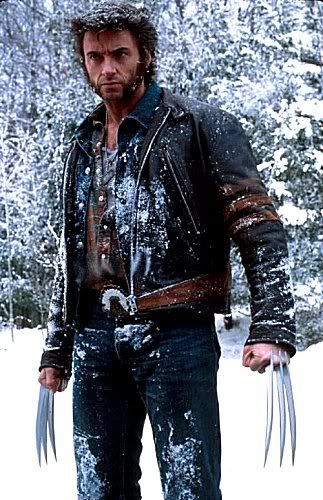
To seal the deal on the Wolverine/Dionysus parallel I'm going to include two images from the beginning and end of the 1987 "Uncanny X-Men Annual" #11 which display the character at the two polar extremes of Dionysian characteristics.
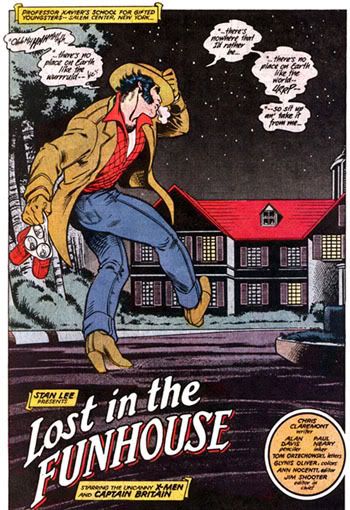
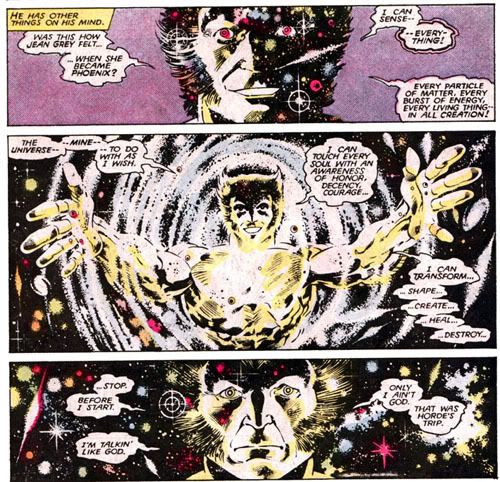
Art by Alan Davis
Don't listen to him. He is a god. The evidence is overwhelming. Want one more item of pure synchronicity? I got one. Wolverine is an anagram of Wine Lover.
No comments:
Post a Comment